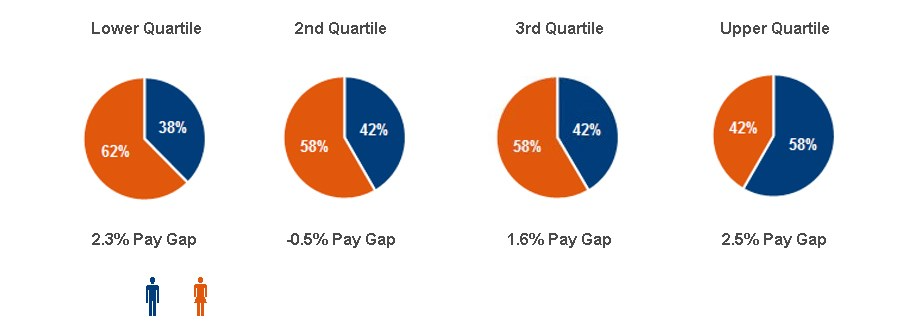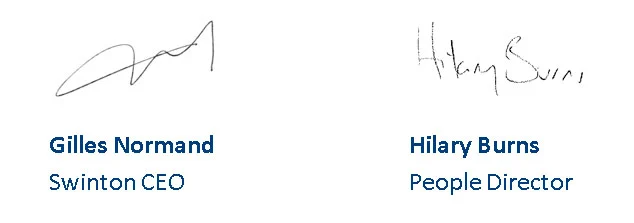Gender pay reporting
This is the first year that all UK companies with over 250 employees have to report differences in gender pay.
It is important to remember that gender pay is not the same as equal pay, which measures whether men and women receive equal pay for equal jobs. All our employees who do the same jobs or work of equal value are paid the same.
Instead it is about ensuring everyone at Swinton, regardless of their background, race, ethnicity or gender, has an equal opportunity to thrive and succeed. By reporting our gender pay gap, it helps us understand the root causes so that we can then take proactive steps to close the gap.
Difference between men and women
Mean Median
13.8% 6.9%
Pay gap (hourly rate)
The table above shows our overall mean and median hourly pay gaps. Both of these rates are below the UK average, which is currently 17.4% (mean) and 18.4% (median).
Our pay gap occurs because there are more male colleagues working in more senior roles, compared to female colleagues. This is shown in the chart below which ranks all our colleagues pay from lowest to highest and then divides it into four equal groups with the first group (Quartile 1) being the lowest paid.
Proportion of males and females in each pay quartile

Within the highest paid group or quartile, there are more males than females, whereas in the other, lower paid groups we have proportionally more females than male colleagues.
We have then calculated the mean pay gap within each of these groups. This helps to understand if there are differences in terms of how we pay males and females within each of these groups. The pay gaps within each of these groups is less than 2.5% which is much lower than our overall pay gap of 13.8%. This again suggests that the overall pay gap is a structural issue rather than a pay one.
Bonus
Every colleague has a part to play in contributing to Swinton's success and we believe it is important that everyone is rewarded fairly for the contribution they make to the performance of our business.
The table below shows the mean and median pay gap for all bonuses earned in the 12 month period up until 5th April 2017.
Difference between men and women
Mean Median
31.6% 27.0%
Bonus Gap
These figures are the result of having more male colleagues in senior roles and also the fact that most part-time positions are typically filled by female colleagues.
As well as reporting our bonus gap, we also report the percentage of colleagues who received a bonus in the 12 month period. Overall, 87% of colleagues received a bonus, however, 91% of males received a bonus whilst only 85% of females received a bonus within this period.
Declaration
We confirm that Swinton’s gender pay gap calculations are accurate and that the methodology provided in The Equality Act 2010 (Gender Pay Gap Information) regulations have been applied correctly.
